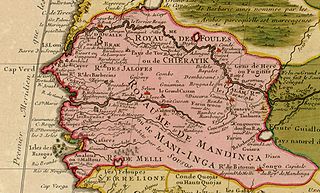
The history of Senegal is commonly divided into a number of periods, encompassing the prehistoric era, the precolonial period, colonialism, and the contemporary era.

The Kingdom of Saloum was a Serer kingdom in present-day Senegal as well as parts of Gambia, then called Lower Saluum. The precolonial capital of Saloum was the city of Kahone. It was a sister to the Kingdom of Sine. Their history, geography and culture were intricately linked and it was common to refer to them as the Sine-Saloum and the Serer Kingdoms of Sine and Saloum.

Biffeche or Bifeche is an area of Senegal centred on the town of Savoigne, around 30 kilometres north-east of the major coastal city of Saint-Louis.
The Principality of Bethio was a small monarchy located for centuries along the lower Senegal River valley, on the border between modern Mauritania and Senegal, in the northeast of Biffeche. In the 18th century it was also called the "Royaume d'Oral." Its capital was at Poum, then moved to N'Dombo, and finally moved to Ross, Senegal in the 19th century. The original, fertile farmlands of Bethio are in a region just east of the Djoudj National Bird Sanctuary.

Baol or Bawol was a kingdom in what is now central Senegal. Founded in the 11th century, it was a vassal of the Jolof Empire before becoming independent in the mid-16th century. The ruler bore the title of Teigne and reigned from the capital in Lambaye. The kingdom encompassed a strip of land extending east from the ocean and included the towns of Touba, Diourbel, and Mbacke. It was directly south of the Kingdom of Cayor and north of the Kingdom of Sine.
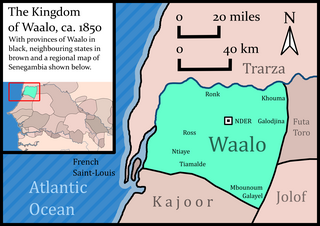
Waalo was a kingdom on the lower Senegal River in West Africa, in what is now Senegal and Mauritania. It included parts of the valley proper and areas north and south, extending to the Atlantic Ocean. To the north were Moorish emirates; to the south was the kingdom of Cayor; to the east was Jolof.
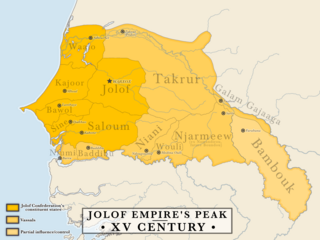
The Jolof Empire, also known as Great Jolof, or the WolofEmpire, was a Wolof and Sereer confederacy state that ruled parts of West Africa situated in modern-day Senegal, Mali, Gambia and Mauritania from around the 12th century to 1549. Following the 1549 battle of Danki, its vassal states were fully or de facto independent; in this period it is known as the Jolof Kingdom.

The Serer people are a West African ethnoreligious group. They are the third-largest ethnic group in Senegal, making up 15% of the Senegalese population. They are also found in northern Gambia and southern Mauritania.
Mö Mboj Maalik Mboj was the last King of Waalo, a pre-colonial kingdom in what is now northern Senegal. He succeeded to the throne as Brak in 1840 and ruled until Waalo was conquered by the French in 1855.

The Kingdom of Sine was a post-classical Serer kingdom along the north bank of the Saloum River delta in modern Senegal. The inhabitants are called Siin-Siin or Sine-Sine.
Maad a Signig Kumba Ndoffene Famak Joof was the King of Sine in modern-day Senegal. Maad a Sinig means king of Sine. He ruled from 1853 until his death on 23 August 1871. He was the son of Maad Souka Ndela Joof and Lingeer Gnilane Jogoy Joof. His father – Maad Souka Ndela came from The Royal House of Semou Njekeh Joof founded by Maad Semou Njekeh Joof in the early 18th century, which was the third and last Royal House of Joof family of Sine and Saloum. His paternal family ruled three Kingdoms : Sine, Kingdom of Saloum and previously the Kingdom of Baol. They descended from Maad Ndaah Njemeh Joof the 13th century King of Lâ (Laah) in Baol.
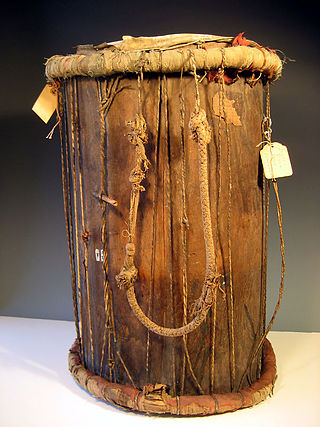
The medieval history of the Serer people of Senegambia is partly characterised by resisting Islamization from perhaps the 11th century during the Almoravid movement, to the 19th century Marabout movement of Senegambia and continuation of the old Serer paternal dynasties.
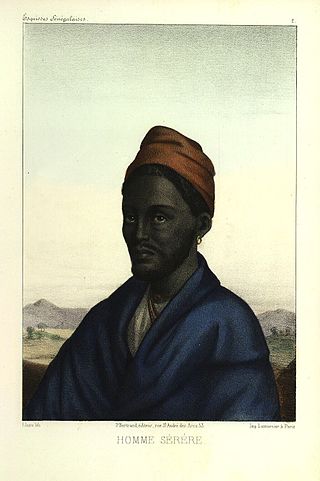
Maad a Sinig Ama Joof Gnilane Faye Joof was a king of Sine now part of present-day Senegal. He reigned from c. 1825 to 1853. He was fluent in several languages. He came from The Royal House of Semou Njekeh Joof. Maad a Sinig means king of Sine in the Serer-Sine language. The term Bur Sine is also used interchangeably with the proper title Maad a Sinig or Mad a Sinig. They both mean king Sine. Bour Sine is usually used by the Wolof people when referring to the Serer kings of Sine. The Serer people generally used the term Maad a Sinig or Mad a Sinig when referring to their kings.

Teigne was a Serer title for the monarchs of the pre-colonial Kingdom of Baol, now part of present-day Senegal. The Kingdoms of Baol and Cayor became intricately linked especially post 1549 when the Faal family came to into prominence, and it was the same family that eventually ruled both Kingdoms with the exception of few interruptions, notably Lat Joor Ngoneh Latir Jobe who was of a different patrilineage.
This is a timeline of the history and development of Serer religion and the Serer people of Senegal, The Gambia and Mauritania. This timeline merely gives an overview of their history, consisting of calibrated archaeological discoveries in Serer countries, Serer religion, politics, royalty, etc. Dates are given according to the Common Era. For a background to these events, see Roog, Serer religion, Serer creation myth, Serer prehistory, Lamane, States headed by Serer Lamanes, Serer history and Serer people.
Linguere Ndoye Demba Joos Fadiou, also known as Ndoye Demba in Senegambian dynastic history, was a Serer princess from the Kingdom of Sine, from the later half of the 14th century to the 15th century. The royal title – "Lingeer" means Queen or Royal Princess. She was given in marriage to the Brak of Waalo – Caaka Mbaar Mbooj. The surname Mbooj is the English spelling in the Gambia, variation include Mboge. In French speaking Senegal, it is spelt Mbodj. Differences in spelling is due to the colonial past of the Gambia and Senegal. France colonized Senegal, whilst Britain colonized the Gambia, thus the division of the two countries. Caaka Mbaar was the second king of Waalo from the Mbooj patrilineage, who ruled in the second half of the 14th century, around 1367. Brak was the title of the kings of Waalo. Lingeer Ndoye Demba was the founder of the Serer Joos Maternal Dynasty of Waalo. In the Wolof Kingdom of Waalo, Lingeer Ndoye Demba is considered the matriarch of the Joos maternal clan. In the Serer Kingdom of Sine, it is her grandmother Lingeer Fatim Beye who is considered to be the matriarch of this maternal dynasty. In the Serer language, the word "Fa-tim" means "the maternal clan of ... ". The Serer surname Beye is also one of the many Serer maternal clans.

Lingeer was the title given to the mother or sister of a king in the Serer kingdoms of Sine, Saloum, and previously the Kingdom of Baol; and the Wolof kingdoms of Cayor, Jolof, Baol and Waalo in pre-colonial Senegal. The word "Lingeer" means "queen" or "princess" in Serer and Wolof language. The Lingeer was considered the “great princess of royal courts.” These kingdoms utilized a bilineal system, as a candidate for kingship could not succeed to the throne if he was not a member of the reigning materlineage, and thus, the Lingeer's maternal lineage was highly significant. In similarity, a candidate could not succeed to the throne as king if he was not a member of the noble reigning patriclans. That was particular so among the Serer who retained much of their old culture, customs and traditional religion where women played a significant role compared to the Wolof who adopted Islam. Various Lingeers have been noted for their resistance efforts to colonial conquest.

Lingeer Fatim Beye Joos Fadiou was a 14th-century Serer princess and queen (Lingeer) from the Kingdom of Sine. She is the matriarch and early ancestor of the Joos Maternal Dynasty of Waalo. She is usually regarded by some sources as the founder of the Joos Maternal Dynasty. The pre-colonial Kingdoms of Sine and Waalo now lies within present-day Senegal. Her surname is Bèye or Beye (French-Senegal). Joos Fadiou is her maternal clan. In Serer, "Fa-tim" means "the maternal clan of..."

The Joos Maternal Dynasty was a Serer maternal dynasty which originated from the Serer pre-colonial Kingdom of Sine in the 14th century and spread to the Wolof Kingdom of Waalo. The matriarch or founder of this maternal dynasty was Lingeer Fatim Beye, a princess and queen originally from the Kingdom of Sine. In Waalo, it was founded by the princess Lingeer Ndoye Demba of Sine. Lingeer Ndoye Demba was the maternal granddaughter of Lingeer Fatim Beye. They both came from the Serer ethnic group. The pre-colonial Kingdoms of Sine and Waalo now forming a part of modern-day Senegal maintained good relations with other pre-colonial kingdoms.
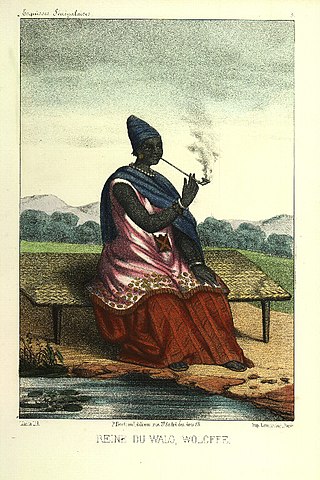
Ndaté Yalla Mbodj, also known as Ndateh Yalla Mbooj, was the last Lingeer (Queen) of Waalo, a Jolof kingdom located in what is now northwest Senegal. During her reign, she fought against French colonization and Moorish invasion of her kingdom. Ndaté Yalla and her sister Ndjeumbeut Mbodj were two of the most powerful women of 19th century Senegalese dynastic history.











